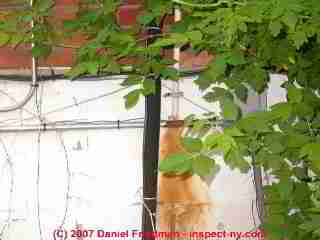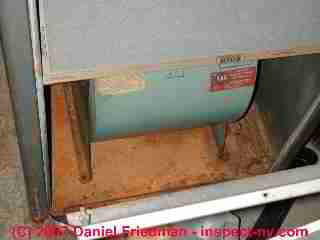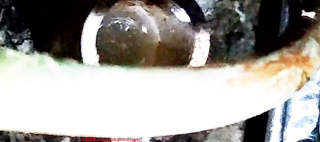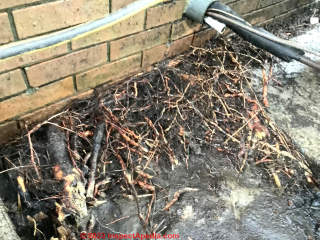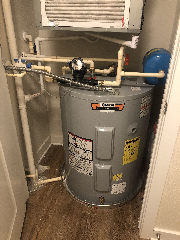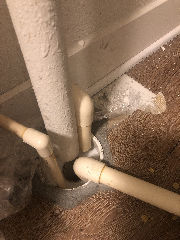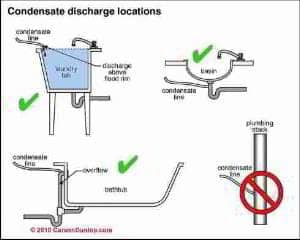 Improper HVAC Condensate Piping & Disposal
Improper HVAC Condensate Piping & Disposal
Condensate drain SNAFUs
- POST a QUESTION or COMMENT about air conditioner or heat pump condensate drain installation, leaks, clogs, troubleshooting, repairs
Improperly-installed A/C condensate piping, drains & pumps:
This article describes undesirable and improper methods for disposing of condensate from an air conditioner or heat pump or similar device.
This air conditioning repair article series discusses the inspection and repair or unclogging of air conditioning condensate systems, including Air Conditioning condensate drains, condensate pumps, and their proper installation as part of our review of condensate piping, traps, drains, condensate pumps, and the detection and hazards of air conditioning system condensate leaks in buildings.
Condensate leak health and safety concerns are reviewed.
InspectAPedia tolerates no conflicts of interest. We have no relationship with advertisers, products, or services discussed at this website.
- Daniel Friedman, Publisher/Editor/Author - See WHO ARE WE?
Examples of Improper Disposal of Air Conditioning or Heat Pump Condensate Disposal
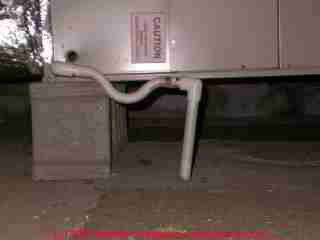 Definition of condensate
Definition of condensate
The liquid that separates from a gas due to a reduction in temperature; for example, water that condenses from flue gases and water that condenses from air circulating through the cooling coil in air conditioning equipment.
Carson Dunlop's sketch at page top shows the proper locations and one improper one (the plumbing vent) for disposal of air conditioner or heat pump condensate.
Condensate disposal by connection to a plumbing stack vent pipe, is not recommended and is prohibited by building code in some jurisdictions.
Our photo of condensate piping below a crawl-space mounted air handler shows another ugly condensate disposal method: dump it on to the dirt crawlspace floor.
[Click to enlarge any image]
Watch out: building codes and code enforcement practices vary among communities and even individual code compliance inspectors. Be sure to check with your local building code compliance department. Commonly in the U.S. individual cities or states or other code jurisdictions atop versions of the 2015 (or earlier) International Mechanical Code (IMC) (Section 307 and others) or the Uniform Plumbing Code. We include examples and excerpts from those codes in the article below.
This article describes that and other air conditioner or heat pump condensate disposal mistakes, troubles, problems. [Click to enlarge any image]
Article Contents
Condensate Drain Leaks & Clogging: Improper Slope
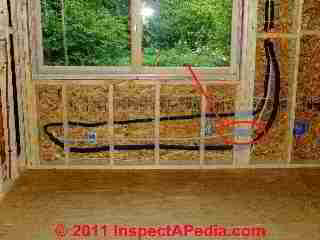 Our photo (left) shows a white flexible tube used as condensate drain tubing for a split system air conditioning system being installed in a New York Home. (click photo to see an enlarged, detailed version).
Our photo (left) shows a white flexible tube used as condensate drain tubing for a split system air conditioning system being installed in a New York Home. (click photo to see an enlarged, detailed version).
Even now the drain is not perfectly sloped (note it's a bit high at that second cripple stud from left) but it was much worse before we re-routed the drain. The air conditioner installer had the drain line sloping up-hill in the area I've circled in the photo.
Having already had condensate drain line clogs and backups and leaks from the indoor air handler into the building wall at another split-system air conditioner where the condensate drain was improperly sloped and clog-prone, I was not going to let it happen again at this installation.
The installer thought I was being unreasonably demanding.
He was ignoring the plumbing code (1/8" per foot slope for condensate drain lines) and apparently he didn't recognize the potential costs in rot, insect damage or mold if we simply let the condensate drain clog (due to an improper slope and dust that will enter the line) followed by leaks into the building wall up at the air handler.
Or this was a plumbing job "... guaranteed until my truck reaches the end of your driveway".
See SPLIT SYSTEM AIR CONDITIONERS & HEAT PUMPS for complete information about the installation, routing, insulation, & protection of condensate drains for split system cooling or heat pump units.
Air Conditioning or Heat Pump Condensate Drains Connected to a Building Plumbing Vent Pipe?

Sewer Gas & Bacterial Hazards at Air Conditioners
[Example air conditioning system inspection report language]:
*** Safety Recommendation: this condensate line is connected to the house drain/vent piping - risking possible bacteria or even dangerous sewer gases entering the building air handling system.
Good practice (and some building and mechanical codes) includes a moisture trap (just as with other plumbing drains) and routing of the condensate to a wet drain line or preferably outside to discharge
into the gutter system or to the ground.
Sewer gases include methane which is an explosive gas. We don't want methane nor bacteria in our air conditioning system.
See Legionella BACTERIA & HVAC EQUIPMENT.
Below is a second example of improperly connected air conditioner condensate drain lines to a plumbing vent: the condensate line is connected to the house drain/vent piping; according to some experts and plumbing codes this is an improper plumbing connection, and for some lines there also is no condensate trap in this plumbing arrangement, risking possible bacteria or even dangerous sewer gases entering the building air handling system.
 Good practice includes a moisture trap (just as with other plumbing drains) to help prevent
this problem.
Good practice includes a moisture trap (just as with other plumbing drains) to help prevent
this problem.
Our understanding is that despite this very common installation found in our area, this is an improper plumbing connection which is dumping liquids into plumbing lines intended for dry-use only.
Correction by a qualified plumber does not usually involve significant expense.
Watch out: HEALTH NOTE: Condensate drains should not be connected directly to a house drain (without an air gap) as bacteria can grow back up the condensate line to contaminate building air, or sewer gases may be drawn up the drain and into the building air when the blower fan is operating.
Reader Comment: traced sewer gas odors to HVAC condensate drain connection to vent stack
22 May 2015 T. W. Straub said:
We just found the source of our septic smell in the East Wing of our home. It appears that the HVAC contractors who installed the system on this wing plumbed the drip line from the air handler into the vent stack without using a P trap. That might have eliminated the problem, but I doubt it would be code compliant.
The way we found the problem was by using a smoke bomb in a shop vac and blowing the smoke down the vent stack from the roof.
While doing that, we looked for smoke in the walls where the stacks were and then looked in the attic. When we opened the access to the attic, we could smell the smoke (Superior #2B - 8,000 cu. ft. smoke bomb) and could see the smoke billowing out of the seams of the air handler. I hope this helps someone else out there --- Tom
Reply:
It's helpful to have a "real world" report confirming what experts have been telling us for a long time and that some installers or building owners simply don't accept.
The convenient shortcut of connecting the HVAC condensate drain to the plumbing stack is overwhelming for some people even though it's a bad idea.
This comment was posted originally at SEWAGE ODOR SOURCE LOCATION.
Also see SEPTIC / SEWER ODOR SOURCE TABLE.
A/C or Heat Pump Spillage in Building Crawl Spaces

Air conditioner condensate spillage in crawl spaces: is sometimes seen, especially if it's a dirt-floor crawl space. The installer probably figures the condensate will just "go away" through the soil exposed in the crawl area.
What s/he failed to consider is the risks of a legionnaire's infection or a mold problem caused by spillage of water into an indoor, and in this case confined and rarely-inspected space.
In our photo, the air handler itself was mounted in a crawl area, making service and repair more difficult and thus more costly. And spilling A/C condensate on the crawl space floor is asking for a building mold or insulation mold problem too.
Air conditioner condensate spillage down building walls: such as the condensate from this attic air handler can stain
the building walls and is simply ugly.
An expert HVAC technician might also have something to say about those rust stains themselves - we
may be looking at rust from inside the air handler, indicating that A/C condensate is spilling and leaking around inside the
unit - perhaps we're actually looking at a hidden mold problem in this building - more investigation would be appropriate.
Safety Hazards of Air Conditioning or Heat Pump System Condensate Leaks Onto a Furnace Heat Exchanger
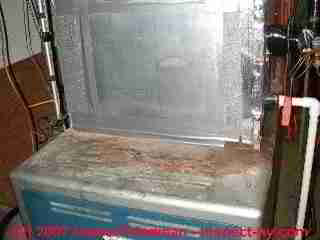
Air conditioner condensate leaks into a furnace as we can see in these two photographs, can be dangerous.
If the air conditioner condensate leaks cause rust holes in the furnace heat exchanger there is risk of dangerous flue gases, including carbon monoxide, leaking into the building air supply when the heater is running.
The rust seen in the bottom of the blower compartment tells us that this problem has gone on for some time.
Further inspection of the heat exchanger is needed for damage, and on most systems, further inspection for mold contamination in the air handler and duct work may also be in order since the system has been spilling water into the air handler and perhaps the ductwork.
Disposal of Air Conditioning or Heat Pump Condensate Outdoors
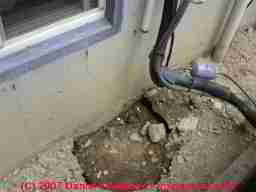 This photograph shows a typical point of disposal of air conditioning condensate outdoors, onto the ground.
This photograph shows a typical point of disposal of air conditioning condensate outdoors, onto the ground.
This A/C condensate line originated at the air handler in the building attic, though at some installations we could be looking at condensate from a condensate pump located
in the building basement.
There's basically no issue with disposing of condensate at this location, though this particular photo shows two more subtle points to watch:
- There is some soil subsidence going on
where the condensate is dripping, telling us that the soil around the foundation is fresh, loose backfill.
Watch out: that the air conditioner compressor/condenser unit does not begin to tip as this backfill settles further from the soil subsidence that will accompany rainfall, snowmelt, and time. Concerns for tipping A/C condenser units are discussed at Air Conditioner Compressor & Condenser Installation Errors. - Foundation leaks:
The second more subtle point to watch that has evidence in this photo is that little shrinkage crack we see in the poured concrete foundation right where the A/C condensate is dripping.
We might see water leaks into the building interior at this point if the foundation is visible indoors, or if the wall has been covered with finish materials we might have a mold problem.
I wouldn't go on to cut open such a wall to investigate this particular case further without other corroborating evidence. More about foundation crack diagnosis is available at How to Diagnose & Evaluate Vertical Foundation Cracks.
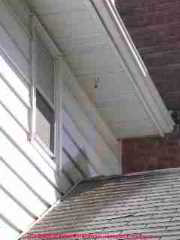
This photograph shows what seems to us to be a sloppy installation of air conditioner condensate drainage.
The installer has sent the condensate drain line outdoors (fine) through the building eaves or soffit (OK) but left the condensate drain pipe terminated where it drips onto a lower roof, splashing up and staining building siding, possibly creating a wear spot on the roof shingles, and thus perhaps a roof leak before the rest of the shingles are ready for replacement.
Question: can A/C condensate drain onto the ground surface?
2018/05/10 Joe said:
In an industrial installation, can the condensate line drain to the wastelands. Is there a code that says it must drain to sanitary?
"Wastelands" refers to Acres of grassy area at our property.
This Q&A were posted originally at CONDENSATE DRAINS, CODES
Reply:
Anon:
The answer is: ... it depends. Clean, pure distilled condensate can be discharged (according to the example municipal guidelines we cite below) but NOT A/C condensate that is contaminated by cleaning agents or other substances.
According to the model plumbing codes and mechanical codes such as the UMC sections UMC 309, UMC 815.2.2, and UMC 1105.10, condensate from an air conditioning or heat pump system can be discharged to "... other points of discharge acceptable to the municipal authority."
Here is a typical guideline for disposal of air conditioning or heat pump condensate from a commercial facility.
2. Condensate from commercial & industrial air conditioning units must terminate in the following order:
i. To a landscaped area or landscape-based stormwater treatment system (e.g. bio-retention unit) that is properly-designed to accommodate the volume of condensate;
or
ii. To the sanitary sewer indirectly. Discharges to sanitary sewer system shall be subject to all wastewater permitting requirements and fees – contact the Environmental Services Department;
or
iii. If the two discharge options described above are not feasible, as determined by the authority having jurisdiction, then these discharges may indirectly enter the storm drain system.
Source: BULLETIN #256 02/10/16, Condensate Disposal Requirements, San José Permit Center, San José City Hall, 200 E. Santa Clara St., San José, CA 95113
408-535-3555 www.sanjoseca.gov/building retrieved 2018/05/11, original source: www.sanjoseca.gov/DocumentCenter/View/53974
Also available at InspectApedia.com at inspectapedia.com/aircond/AC-Condensate-Disposal-Guide-San-Jose-CA.pdf
The reason we don't connect condensate discharge piping *directly* or hard-piped to a sewer or storm drain (nor directly into a plumbing system vent pipe) is risk of explosive or unsanitary sewer gases being drawn into the building's HVAC system. That's why air gaps and traps are required for such connections, making the connection "indirect".
Watch out: you absolutely must check with your local building or plumbing code enforcement officials about your HVACR condensate disposal plan as municipalities vary in what they permit.
In that discussion it is essential to be perfectly clear and honest about exactly what is in your condensate drainage. For example, does the condensate contain biocides, chemicals, treatments that may not be properly discharged into the environment. Knoxville's guidelines address this concern:
It is allowable to discharge condensated water, which is essentially pure water from the atmosphere. It is illegal to discharge any water that contains chemicals, detergents, algae-killing agents and other manmade substances onto the ground or onto any surface which drains to the city stormwater drainage system, ditches, swales, curbs, natural creeks and streams or wetlands.
It is illegal to discharge any substance (liquid or solid) to the environment in any manner that could allow the substance to wash into the municipal stormwater drainage system, ditches, swales, natural streams and creeks, wetlands or sinkholes.
This prohibition is mandated by federal and state regulations, and also included in the Stormwater and Street Ordinance (Chapter 22.5 of the City Code).
The City of Knoxville is required to prohibit non-stormwater discharge as part of the National Pollutant Discharge Elimination System (NPDES) permit issued to the City of Knoxville by the state of Tennessee.
The City Engineering Department website contains the current ordinance and NPDES permits. See IC-01 (Non-Stormwater Discharges to Storm Drains) for a list of exempted discharges.
Both air conditioning condensate and refrigeration condensate are on the list of allowable discharges, provided that such water is distilled pure water taken from the atmosphere. However, any cleaning water or washwater can not be discharged to the ground, but must be captured for disposal in the sanitary sewer system.
Source: IC-12 Air Conditioners & Refrigeration, [PDF] City of Knoxville TN Engineering Department (2003) retrieved 2018/05/11 original source: www.knoxvilletn.gov/UserFiles/Servers/Server_109478/File/Engineering/BMPManual/IC-12.pdf
A copy of this bulletin is also available at Inspectapedia.com at inspectapedia.com/aircond/AC-Condensate-Disposal-Knoxville-TN-2003.pdf
Air Conditioning or Heat Pump Condensate Drains Routed to Hidden Locations
 Condensate drains routed to hidden locations:
Condensate drains routed to hidden locations:
What about installers who route a condensate drain to some hidden location?
The drains in this photo might be ok, or maybe not - it depends. If they disappear into an inaccessible or not readily visible
location such as a crawl space the system is asking for trouble - such as a wet moldy crawl space.
If the drains appear outside or at some other visible location we're in good shape. In this particular case, the air conditioning system for the computer center of a large college was draining onto the floor of a utility room where condensate ran along drywall and then across to a floor drain.
The drywall gave us a little area of mold to clean up but luckily nothing of any consequence. We could see the ends of this drain
if we looked long enough.
The discharge point of all of the air conditioning system
condensate drain lines,
that is the system condensate drain and the air conditioner condensate overflow pan drain,
must be readily observable
(Ref. Uniform Mechanical Code Sec. 1205 and Sec. 510.
Condensate overflow pan is suggested for attic space per UMC (Uniform Mechanical Code - Section 1205.)
HVACR Condensate Drain Failure Research
- CONDENSATE DISPOSAL, IMPROPER - web article
- Des Champs, Nicholas, H., Ph.D., P.E., Fellow ASHRAE, HVAC, CHECK VALVE ALTERNATIVE to P-TRAP for HVAC CONDENSATE [PDF] (2020) HPAC Engineering, eNewsletter, Web: hpac.com - retrieved 2022/07/23, original source: https://www.hpac.com/piping-pumping/article/21130312/time-to-reconsider-use-of-ptraps-for-condensate-removal
- Thomasnet, PREVENTIVE MEASURES TO AVOID CHECK VALVE FAILURES, IN THE ESSENTIAL GUIDE TO PREVENTING CHECK VALVE FAILURE, [PDF] (2018) Thomas Engineering, - retrieved 2022/07/23, original source: https://www.thomasnet.com/insights/guide-to-preventing-check-valve-failure/
...
Reader Comments, Questions & Answers About The Article Above
Below you will find questions and answers previously posted on this page at its page bottom reader comment box.
Reader Q&A - also see RECOMMENDED ARTICLES & FAQs
On 2023-11-24 by InspectApedia Publisher - install a small condensate pump that simply lifts the condensate up to an appropriate building drain
@Nia,
An alternative method for handling condensate waste from HVAC equipment is to install a small condensate pump that simply lifts the condensate up to an appropriate building drain. That avoids the problem of freezing at the sump pump outlet and maybe simpler than having to maintain a heat tape on the sump pump line.
On 2023-11-24 by Nia
@InspectApedia Publisher,
Install heat tape suitable for pvc? Find another discharge method - I guess I could go back to the last route, which was discharged into a 5 gallon bucket for manual emptying.
It can be super dry during winter, but this autumn seemed to produce more condensate than usual. I guess I will only use the sump pump for condensate discharge when outside is above freezing.
On 2023-11-20 by InspectApedia Publisher - a buildup of ice can eventually block the outlet pipe
@Nia,
I have a lot of experience with this specific problem in northern Minnesota and I can assure you that eventually they pump outlet will freeze and potentially then block the ability of the sump pump to discharge condensate.
Even a small amount of water remaining in the end of the outlet pipe after the pump cycle stops will be enough to freeze and that accumulates over a sequence of pump cycles. The result can be a buildup of ice that eventually blocks the outlet pipe.
We have photos of that condition at this website.
On 2023-11-20 by Nia
@InspectApedia Publisher,
According to the installers, my sump pump is supposed to be inactive during the winter months in MN, due to freezing temperatures. If I am dumping condensate into it, it will eventually set off the automatic pump.
I am hoping that the expression will be quicker than it takes to freeze the condensate, which would have a lower freezing point due to ph level; expression is very fast during mild temperatures.
As is, the extension to the discharge tube (outside of house) has been removed per installer's instruction for winter months. So the discharge tube sticks out only a few inches from exterior wall.
One of the arguments others have made (reddit forum) is something akin to sump pump not operational during winter months. I guess in subzero temperatures, I can keep an eye on the discharge tube to see if it has any frozen condensate blocking the opening.
On 2023-11-09 by InspectApedia Publisher - can the acidity of air conditioning condensate be a problem in sump pump life
@Nia,
I will do some further research, but I haven't yet found scholarly research that claims that the acidity of air conditioning condensate is a problem in sump pump life.
It is a concern that condensate can become a breeding ground for legionella bacteria in some conditions.
A proper sump installation includes a cover so that you're not overly concerned about a small amount of water that remains in the pit when the sump is not active.
And in regular use new incoming condensate should cause the pump to flush out the sump pit.
But certainly if that's a concern for you dumping a little dose of bleach in there when the system is not expected to be producing condensate for weeks or months at a time should be sufficient
On 2023-11-08 by Nia
(1) Can the discharge from the heat/ac system drain directly into sump pump?
(2) Will the (assumed) high acidity of discharge corrode the sump system? My soil is clay and water is quite hard if untreated. Do those characteristics help play into neutralizing the discharge fluid?
(3) Is there danger of stale water sitting in sump pump pit affecting the hvac (ie- bacteria)?
On 2022-06-27 by InspectApedia-911 (mod) - water accumulates on top of the filter when the air handler is operating
@charles,
Take a look in your air handler or attach a photo or a sketch so that we can see what's going on.
I don't know whether the water is blowing off of the air handler squirrel cage blower fan or weather there is a condensate and above it that is not draining.
On 2022-06-27 by charles
water accumulates on top of the filter when the air handler is operating
On 2021-10-17 by inspectapedia.com.moderator - problems with draining condensate underneath the floor slab
@Harvey Kelly,
It is indeed the case that some installers thought it would be okay to simply drain condensate underneath the floor slab.
It may go right into the soil or there may have been, at one time, a drain line that connected to a sewer line or even to a footing drain system.
For the circumstance of blockage that you describe, it makes sense to me to abandon that drain.
You can route the condensate to the exterior and if necessary you can use a condensate pump to lift it to drain properly.
On 2021-10-17 by Harvey Kelly
My condensation line for the furnace drains into the concrete floor slab. There is no outdoor drain that I can see. I have to assume that it is either draining into the house sewer system or draining directly into the ground below the concrete.
The last copy of years I have been having issues with pvc pipes of the drain being clogged and the water just spills back into the furnace and drips on the floor.
I tried some vinegar and over the counter drain cleaner but it does not solve the problem. I tried to snake the drain under the furnace but I can barely get to a inch into the pipe and I hit something hard. I can't break thru it. I stuck a metal piece down the pvc drain and it hit something hard and I can push thru it.
I tried to take pictures of the inside of the drain and posted under the furnace and have posted them. Those are the best that I can take of what inside the pipe. The vinegar and cleaner appear to be stuck in the pipe.
I guess my question is how can I determine if the issue is that the drain line is draining into the ground under the foundation. Or does it actually drain into the sewer line or suppose to but something is clogging it.
I want to just drill a hole thru the wall and run a drain line to the outside wall which is about 7 feet from the furnace. This way it would be easier to clean and hopefully solve the problem.
I attached the best picture that I could get in the limited space. I would appreciate your opinion on what appears to me to be a metal grate in a plastic pipe. I could be wrong as it might be something else. Thank you for taking my question.
On 2021-09-22 by inspectapedia.com.moderator - condensate causes roots to grow and harm the foundation
@Joseph Mann,
Thank you for the interesting photo and condensate disposal question. It's entirely common to dump A/C condensate onto the soil next to a building so long as it doesn't spill across a public walkway nor re-enter the building through the foundation wall.
It's surprising to see so much condensate draining in a location that it would attract roots from distant plants sufficient to cause root damage to a foundation, and more-so to see a 2" diameter root against a foundation that's just three years old.
What plants are growing near the building? Size, age, species.
How far are they from the building wall?
Is this a building on slab, on crawl space, or over a basement?
If either of the latter two, what can we see from inside that space?
What's the volume of condensate being drained here? From how-big a building, in what climate?
Before fixing the problem by routing condensate to a more-distant disposal point, let's be darn sure we've correctly identified the cause of the root problem.
On 2021-09-22 by Joseph Mann
My HVAC condensation pipe drains beside the foundation. It is less than 3 years old. I’m attaching image of the roots induced by the drain being placed beside the foundation of the house. It has undermined the foundation of the house. Is this a “code acceptable instillation?”
On 2021-09-12 by Big Rich
@inspectapedia.com.moderator,
Thank you for your answer.
On 2021-09-11 by inspectapedia.com.moderator - residential A/C condensate will not affect a septic system
@Big Rich,
Residential A/C condensate will not affect a septic system. The condensate volume is trivial vs wastewater volume.
On 2021-09-11 by Big Rich,
@inspectapedia.com.moderator,
I bring up the septic tank as opposed to a sewer system because with a sewer, it's gone when it leaves the house. For septic, it's important that I don't upset the delicate pH balance and change the way it can self-consume a good percentage of waste.
I was VERY surprised when the "French drain" or "drywell" as you call it started backing up this year. I never thought the clay content in that area was that bad. My septic leach field passed the perk test. Unfortunately, the rest of the property is plagued with hard soil and it's worse than just a puddle, it's slippery as ice when it mixes with the clay.
Bottom line, since the drywell did not work, I feel I need to get the condensate into the septic even if I may need to treat it for acidity so as not to harm the "good bacteria" that a septic system needs.
Thank you for your comments.
On 2021-09-11 by inspectapedia.com.moderator
@Big Rich,
No and let me apologize: when readers post long messages and when we have many many to which we want to reply, the moderator might sometimes read a bit fast, skimming for the key question to which we try to offer a useful reply.
It is common practice and not normally a problem to spill A/C condensate onto the soil outside a home - as long as the water isn't re-entering or wetting the building siding.
Your New Jersey solution, with a trap and an air gap, should have been acceptable to local code inspectors as well as functional.
Outside if your North Carolina condensate forms an annoying puddle then there's a surface slope/runoff problem or impervious clay soil - things to be solved outside by grading and soil material and adequate absorption area.
I don't quite get why the septic tank would have anything to do with proper condensate drainage.
Sending condensate into a home-made drywell would be fine, except I would never bury the end such that it or the drywell might freeze up. An air gap is a good practice.
On 2021-09-11 by Big Rich
@inspectapedia.com.moderator,
Well, as I stated, the condensate drain line is on a check valve (one-way valve) which would act like the original clean-out plug except to let condensate into the pipe and on to the septic tank.
My system here is a private septic tank, not a public sewer like I had in Jersey. The clean-out is not in a wall or any living space, it's in the crawlspace under my house (as in the picture).
There is no way for the sewage to get into the condensate pump reservoir let alone any living space.
Do you still feel it might be a problem, or did I confuse the story and you thought I was on a public sewer?
On 2021-09-11 by inspectapedia.com.moderator - things to watch for if an HVAC condensate drain is routed improperly into a sewer line
@Big Rich,
The "worst things" to watch for if an HVAC condensate drain is routed improperly into a sewer line would be back-contamination of the building air with sewage pathogens and methane gas, making people sick, or a condensate drain blockage entirely that shuts down the system or leaks into the building cavities causing mold contamination.
On 2021-09-11 by Big Rich
I’ve seen numerous posts about draining condensate and I’m still a little unsure.
I have a condensate drain problem (again). I could not disagree more with the folks that reply that anyone should simply put a line outside on the ground. Let me explain.
I used to live in New Jersey and had a direct vent furnace which ended up with the issue of the freezing condensate drain line plugging the line and subsequent flooding. I had sewer in Jersey so I rerouted the condensate line to a washing machine drain above the waterline so there could be no suction siphon effect. It worked flawlessly.
We moved and I now live in a fairly temperate climate in east central North Carolina but is does get down in the 20’s here so I also use the condensate pump to drain my steam humidifier which is in the crawlspace too along with the HVAC Heat Pump system.
I have my condensate drain outside (where the home builder put it) and the first summer it produced so much condensate that there was a puddle. At first the puddle would seep in or evaporate but eventually it became a hazard because it was not evaporating fast enough and grew a form of slippery mildew which was as slippery as ice, no exaggeration.
Here in North Carolina too I had a few times the condensate line would freeze outside and became a plug which of course backed up into the crawlspace for a mini flood.
Here in North Carolina, I have a septic tank and two problems, the slippery build-up in the summer and the freeze backup in the winter.
I dug a hole about 3 feet deep, well below the frost line and placed a 5 gallon bucket with a lot of drain holes in its bottom and lined with weed block fabric. I filled the bucket with small drainage rock wrapped in the weed block fabric.
I placed the end of the condensate drain line into the bucket and wrapped the line in tubular insulation all the way back into the crawlspace. This worked well, no problems for 6 years.
Now the insulation has dry rotted and needs to be replaced. No big deal, normal wear and tear. But now (summer) I see the area around where the bucket is buried with that same slimy mildew stuff and occasionally a puddle.
I’m DONE with outside condensate drainage. I’m also way too old to be digging that whole “French drain” mess back up and now I want to put it inside. My house is plumbed in all PVC.
I would like to drill a hole in a 3” PVC clean-out plug and epoxy in a connector which would go back to my condensate pump. I would put a loop in the line to act as a trap and the condensate pump output is already going through a check valve so I’m sure there will be no septic tank back-flow even in a clog emergency.
If I needed to use the clean-out, it would be simple enough to disconnect the condensate hose from it before backing it out.
My question is, what is the WORST thing or things I need to expect from draining steam humidifier water (Aprilaire 800) and A/C condensate from my heat pump HVAC and crawlspace dehumidifier into my septic tank through the clean-out plug?
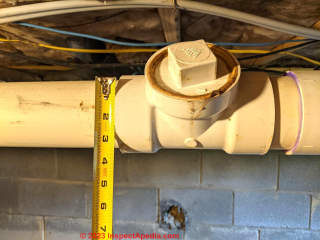
Question: condensate drain piped into insulated wall cavity
I’m living in a brand new home that was completed in August 2020.
I noticed moisture coming from between the framing and foundation at a spot in my finished garage and a plumber I brought in found that the condensate drain line from my furnace was piped down to the crawl space and ended within the insulation.
I’m upset that this is happening in my brand new home, though I’m glad I caught it. I’d like to know what I should ask the builder to do to remedy this, as I can’t imagine that a short pipe pointing to the crawl space, but ending in the insulation is how it’s supposed to be. The wood is already degrading :(
Sincerely, Frustrated in Seattle
Moderator reply:
Sincerely, a condensate needs to connect to a drain or to the building exterior.
Dumping condensate into a wall, ceiling, or floor cavity wets the insulation, framing, drywall or other building materials, inviting costly and potentially dangerous mold contamination as well as inviting rot and insect damage to the structure.
Question: is it ok to drain condensate into an open sewer pipe?
2019/07/15
Living in a newly constructed apartment and have a question...
The building is three stories high with 8 units on each floor. The floor plans reflect the unit above and below.
Each units' A/C condensation has a PVC drip line that connects it to the unit below. On the first floor, the upper-units' and bottom floor units all come together and drip into an opening in the floor into a raw sewage line, what appears to be a 3in section of pvc that is flush to the floor but wide open.
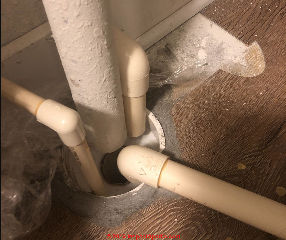 Is this a normal set-up? Are raw sewage lines usually sealed and is it typical for the bottom floor unit to have to suck up everyone else's drainage?
Is this a normal set-up? Are raw sewage lines usually sealed and is it typical for the bottom floor unit to have to suck up everyone else's drainage?
I ask because these are brand new apartments but multiple units have flooded with raw sewage and we wonder if we're next...thanks in advance
This Q&A were posted originally at AIR CONDITIONING & HEAT PUMP SYSTEMS
Reply: an untrapped sewer line is unsanitary and unsafe
This closeup of what looks like a floor drain, excerpted from md's second photo below, shows what looks like two condensate drains and a water heater overflow pan draining into an opening in the floor.
The reason that plumbing and air conditioning codes call for a trap on the condensate line at the air handler is specifically to prevent drawing unsafe, unsanitary gases including sewer gas into the building's air duct system.
If your condensate drains are properly trapped, then the risk therefore of sewer gases being picked up out of this drain and sent into the building are small.
Watch out: nevertheless, If this is an untrapped drain and worse if it is connected to a sewer line, the risk of sewer gases (explosive and unsanitary) would make this an improper and unsafe installation.
On 2020-09-07 - by (mod) -
Lynda
AC tech may be correct that the condensate drain heads outdoors but that doesn't answer the question of whether or not the drain is clogged, has a dip in the piping, or is otherwise leaking or overflowing to cause condensate dripping in a wall, attic, crawlspace or other location.
What's needed as more thorough visual inspection to find the leak. Start of the air handler to look for an overflowing condensate pan.
On 2020-09-07 by Lynda
My AC is located in a closet near the front door, when AC stops running a dripping sound begins about 10 minutes later in the kitchen near the ceiling by the vent stack which about 10 to 12 feet from AC unit is located. AC repair tech say the drain line goes outside.
Is there a secondary drain line that goes to the vent stack.. I have had to raise the temperature on my AC to slow the dripping down. Had 2 leak searches and no one knows where the leak is coming from. No AC on no leaking. I live in Florida you can't live here without AC
On 2020-05-14 - by (mod) -
Lodi
I would extend the drain line as needed
On 2020-04-21 by Lodi Josef
My AC is in the attic of my 2 story house. The condensate line terminates about 6 inches out of the exterior wall and it is staining the walls below it 2 floors down. Do I reroute the line or can I attach PVC lines vertically down where the condensate terminates to avoid staining my walls?
On 2019-07-30 - by (mod) -
At CONDENSATE HANDLING. https://inspectapedia.com/aircond/Condensate_Handling.php
You will find a table of the minimum condensate drain pipe sizes
On 2019-07-30 by Jeff
Yea, the rest of the basement is finished which is why I want to do something should the water heater fail. I think I am going to extend the output of the drain pan to directly over the floor drain and then mode the condensate lines to smaller diameter tubing so as to fit all three right above the drain
Thanks again
On 2019-07-30 - by (mod) -
Watch out: if as your photo suggests, there is a wall cavity that could flood from water heater leaks or drywall that could be wet, then there's a risk of water damage, mold damage, etc. from a water heater spill onto that basement floor; in that case it's better to have the drain pan just as it's shown in your photo.
On 2019-07-30 - by (mod) -
 Actually I'd leave that installation as it is, PROVIDED that the ends of the AC condensate drains are NOT immersed in the trap water - we want an air gap there.
Actually I'd leave that installation as it is, PROVIDED that the ends of the AC condensate drains are NOT immersed in the trap water - we want an air gap there.
You're right that TPR valve manufacturers and the manufacturers of appliances on which they're used all advise periodic testing by opening the valve.
It's NOT something to try on a Sunday Night when the plumbing suppliers are closed, as if the valve spits out a washer or otherwise jams internally and keeps spewing water you have to shut down the equipment entirely (as well as turning off its water supply).
Sometimes we can flick the valve lever as you did, OR tap lightly on the valve stem, and it will unstick itself and close properly.
If there is the slightest doubt about a pressure relief valve's reliability it should be replaced.
E.g. if a valve has been dripping or leaking for a long time I've seen so much mineral scale form inside the valve body that it would no longer open in response to an over-pressure or over temperature condition.
On 2019-07-30 by Anonymous
Thanks for the quick response...I believe the pan is to code. Benefit I see is that if leaks occur they are better contained and can be directed to a drain. In this case the last part was not so well executed on.
Agree on the corrosion concern...
Regarding the relief valve, reading my WH manual, apparently you are supposed to exercise it regularly.
Flicked it a few times and it seems well seated now but will check out what you mentioned.
I’ve attached a picture...if you have any suggestions please let me know
Thanks again
On 2019-07-30 - by (mod) -
Jeff,
That idea sounds reasonable but has a couple of concerns about which you can think, investigate, comment further.
1. There must be absolutely NO standing water left in the overflow pan from condensate draining into the pan. Otherwise you risk growth of harmful mold or bacteria such as the legionnaire bacteria problem associated with AC systems.
Legionella BACTERIA & HVAC EQUIPMENT https://inspectapedia.com/aircond/Legionella_Prevention_HVAC.php has details.
2. Depending on the support under the water heater that keeps any metal parts off of the overflow / leak pan surface, if the pan is kept constantly wet with A/C condensate there could be rust damage to the water heater bottom.
3. When a water heater is in a basement next to a floor drain and sitting on a concrete floor that slopes to the drain, I'm unclear what benefit is offered by the spill pan under the water heater.
Spill pans are placed under water heaters and washing machines when they are installed on an upper floor in a building, principally to catch what should be very rare leaks or spills in time to prevent them from damaging finish flooring in those areas. It sounds to me as if somebody just took a generic " install the pan " approach without much thought.
Or perhaps a local inspector demanded it.
It may make more sense to simply remove the leak pan given it's not contributing anything in your installation and to keep the AC condensate's location draining right into the floor drain.
4. The real danger here that hasn't been addressed is the stuck-open TPR valve.
The concern is that the valve may not function as it should in response to a true over-temperature or over-pressure condition, risking a dangerous BLEVE explosion of the water heater.
(Search InspectApedia.com for BLEVE EXPLOSION to read details).
So it may make sense to replace the TPR valve.
On 2019-07-30 by Jeff
My HVAC condensate has two pipes draining into a single 1.5” floor drain in my basement. HW heater installed a few years ago and does have a drain pan. Unfortunately when the TPRV stuck opened last week we realized that the drain pan just spills on the floor a few inches from the floor drain. Likely because there is no room in the drain.
So I was thinking of running the condensate drains into the pan and the HW pan to the drain. Logic is that if the WH fails there will be a lot faster flow so I want that to flow directly into the floor drain.
So, what are your concerns with the condensate going into the WH pan? Other suggestions?
TIA
On 2019-07-28 - by (mod) -
Brian
No; A/C condensate could be unsanitary, unsafe, for example possibly containing legionnaire's disease-causing bacteria. See Legionella BACTERIA & HVAC EQUIPMENT https://inspectapedia.com/aircond/Legionella_Prevention_HVAC.php
The condensate drain ought not be spilling into a plumbing fixture where it can come into contact with a person.
On 2019-07-28 by Brian
The condensate drain in my daughters apartment drains to her bathtub. In fact hits her right between the eyes when when is soaking. Is this legal of even acceptable practice.
...
Continue reading at CONDENSATE DRAIN CLEAN & DE-CLOG or select a topic from the closely-related articles below, or see the complete ARTICLE INDEX.
Or see CONDENSATE DRAIN PROBLEM FAQs - questions & answers posted originally on this page.
Or see this
Recommended Articles
- CONDENSATE HANDLING, HVAC - home
- CONDENSATE LEAKS
- CONDENSATE PUMPS
- CONDENSATE DISPOSAL, IMPROPER
- CONDENSATE DRAINS, CODES
- CONDENSATE DRAIN CLEAN & DE-CLOG
- CONDENSATE DRAIN INSULATION REQUIREMENTS
- CONDENSATE DRAIN PROBLEMS
- CONDENSATE DRIP TRAY DEFECTS
- CONDENSATE PAN SWITCH LOCKOUT
- Legionella BACTERIA & HVAC EQUIPMENT
- CONDENSING BOILER/FURNACE CONDENSATE DRAIN
- HARTFORD LOOP
- Legionella BACTERIA & HVAC EQUIPMENT
- SPLIT SYSTEM AC CONDENSATE LEAK REPAIR
- CONDENSING BOILER/FURNACE CONDENSATE DRAIN
Suggested citation for this web page
CONDENSATE DRAIN PROBLEMS at InspectApedia.com - online encyclopedia of building & environmental inspection, testing, diagnosis, repair, & problem prevention advice.
Or see this
INDEX to RELATED ARTICLES: ARTICLE INDEX to AIR CONDITIONING & HEAT PUMPS
Or use the SEARCH BOX found below to Ask a Question or Search InspectApedia
Ask a Question or Search InspectApedia
Try the search box just below, or if you prefer, post a question or comment in the Comments box below and we will respond promptly.
Search the InspectApedia website
Note: appearance of your Comment below may be delayed: if your comment contains an image, photograph, web link, or text that looks to the software as if it might be a web link, your posting will appear after it has been approved by a moderator. Apologies for the delay.
Only one image can be added per comment but you can post as many comments, and therefore images, as you like.
You will not receive a notification when a response to your question has been posted.
Please bookmark this page to make it easy for you to check back for our response.
Our Comment Box is provided by Countable Web Productions countable.ca
Citations & References
In addition to any citations in the article above, a full list is available on request.
- Mark Cramer Inspection Services Mark Cramer, Tampa Florida, Mr. Cramer is a past president of ASHI, the American Society of Home Inspectors and is a Florida home inspector and home inspection educator. Contact Mark Cramer at: 727-595-4211 mark@BestTampaInspector.com 11/06
- Roger Hankey is principal of Hankey and Brown Inspections, Winter Park, CO. Mr. Hankey is a past chairman of the ASHI Standards Committee and served in other ASHI chapter and national leadership roles. Mr. Hankey is a National Radon Proficiency Program certified measurement professional and a Level II infrared thermographer. Contact Roger Hankey at: 970-393-6604 - rogerhankey47@gmail.com . Website: www.HankeyandBrown.com Mr. Hankey is a frequent contributor to InspectAPedia.com.
- In addition to citations & references found in this article, see the research citations given at the end of the related articles found at our suggested
CONTINUE READING or RECOMMENDED ARTICLES.
- Carson, Dunlop & Associates Ltd., 120 Carlton Street Suite 407, Toronto ON M5A 4K2. Tel: (416) 964-9415 1-800-268-7070 Email: info@carsondunlop.com. Alan Carson is a past president of ASHI, the American Society of Home Inspectors.
Thanks to Alan Carson and Bob Dunlop, for permission for InspectAPedia to use text excerpts from The HOME REFERENCE BOOK - the Encyclopedia of Homes and to use illustrations from The ILLUSTRATED HOME .
Carson Dunlop Associates provides extensive home inspection education and report writing material. In gratitude we provide links to tsome Carson Dunlop Associates products and services.


